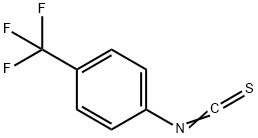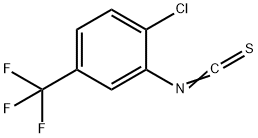4-(TRIFLUOROMETHYL)PHENYL ISOTHIOCYANATE
- CAS NO.:1645-65-4
- Empirical Formula: C8H4F3NS
- Molecular Weight: 203.18
- MDL number: MFCD00039645
- SAFETY DATA SHEET (SDS)
- Update Date: 2023-04-23 13:52:06

What is 4-(TRIFLUOROMETHYL)PHENYL ISOTHIOCYANATE?
Chemical properties
white to slightly yellow crystalline needles or chunks
The Uses of 4-(TRIFLUOROMETHYL)PHENYL ISOTHIOCYANATE
4-(Trifluoromethyl)phenyl isothiocyanate may be used in the synthesis of 6-[1-amino-3-(4-trifluoromethylphenyl)-thiourea]-2-ethylbenzo[de]isoquinoline-1,3-dione. It may also be used in the synthesis of photoinduced electron transfer (PET) sensors.
Synthesis Reference(s)
Tetrahedron Letters, 38, p. 1597, 1997 DOI: 10.1016/S0040-4039(97)00121-4
General Description
4-(Trifluoromethyl)phenyl isothiocyanate, also referred as p-trifluoromethylphenylisothiocyanate, is an isothiocyanate derivative.
Properties of 4-(TRIFLUOROMETHYL)PHENYL ISOTHIOCYANATE
| Melting point: | 39-43 °C(lit.) |
| Boiling point: | 81 °C11 mm Hg(lit.) |
| Density | 1.3395 (estimate) |
| Flash point: | >230 °F |
| form | powder to lump |
| color | White to Light yellow |
| Sensitive | Moisture Sensitive |
| BRN | 2693553 |
| CAS DataBase Reference | 1645-65-4(CAS DataBase Reference) |
| NIST Chemistry Reference | P-trifluoromethylphenylisothiocyanate(1645-65-4) |
Safety information for 4-(TRIFLUOROMETHYL)PHENYL ISOTHIOCYANATE
| Signal word | Danger |
| Pictogram(s) |
 Corrosion Corrosives GHS05  Health Hazard GHS08 |
| GHS Hazard Statements |
H314:Skin corrosion/irritation H334:Sensitisation, respiratory |
| Precautionary Statement Codes |
P260:Do not breathe dust/fume/gas/mist/vapours/spray. P280:Wear protective gloves/protective clothing/eye protection/face protection. P284:Wear respiratory protection. P303+P361+P353:IF ON SKIN (or hair): Remove/Take off Immediately all contaminated clothing. Rinse SKIN with water/shower. P305+P351+P338:IF IN EYES: Rinse cautiously with water for several minutes. Remove contact lenses, if present and easy to do. Continuerinsing. |
Computed Descriptors for 4-(TRIFLUOROMETHYL)PHENYL ISOTHIOCYANATE
| InChIKey | DQEVDFQAYLIBRD-UHFFFAOYSA-N |
New Products
4-Fluorophenylacetic acid 4-Methylphenylacetic acid N-Boc-D-alaninol N-BOC-D/L-ALANINOL Tert-butyl bis(2-chloroethyl)carbamate 3-Morpholino-1-(4-nitrophenyl)-5,6-dihydropyridin- 2(1H)-one Furan-2,5-Dicarboxylic Acid Tropic acid S-2-CHLORO PROPIONIC ACID ETHYL ISOCYANOACETATE 2-Bromo-1,3-Bis(Dimethylamino)Trimethinium Hexafluorophosphate (6-METHYL-[1,3]DITHIOLO[4,5-b]QUINOXALIN-2-ONE INDAZOLE-3-CARBOXYLIC ACID 4-IODO BENZOIC ACID (2-Hydroxyphenyl)acetonitrile 4-Bromopyrazole 5,6-Dimethoxyindanone 2-(Cyanocyclohexyl)acetic acid 4-methoxy-3,5-dinitropyridine 2-aminopropyl benzoate hydrochloride 1-(4-(aminomethyl)benzyl)urea hydrochloride diethyl 2-(2-((tertbutoxycarbonyl)amino) ethyl)malonate tert-butyl 4- (ureidomethyl)benzylcarbamate Ethyl-2-chloro((4-methoxyphenyl)hydrazono)acetateRelated products of tetrahydrofuran








You may like
-
 4-(Trifluoromethyl)phenyl isothiocyanate CAS 1645-65-4View Details
4-(Trifluoromethyl)phenyl isothiocyanate CAS 1645-65-4View Details
1645-65-4 -
 4-(Trifluoromethyl)phenyl Isothiocyanate CAS 1645-65-4View Details
4-(Trifluoromethyl)phenyl Isothiocyanate CAS 1645-65-4View Details
1645-65-4 -
 4-(Trifluoromethyl)phenyl isothiocyanate CAS 1645-65-4View Details
4-(Trifluoromethyl)phenyl isothiocyanate CAS 1645-65-4View Details
1645-65-4 -
 1975-50-4 98%View Details
1975-50-4 98%View Details
1975-50-4 -
 2-HYDROXY BENZYL ALCOHOL 98%View Details
2-HYDROXY BENZYL ALCOHOL 98%View Details
90-01-7 -
 2-Chloro-1,3-Bis(Dimethylamino)Trimethinium Hexafluorophosphate 221615-75-4 98%View Details
2-Chloro-1,3-Bis(Dimethylamino)Trimethinium Hexafluorophosphate 221615-75-4 98%View Details
221615-75-4 -
 14714-50-2 (2-Hydroxyphenyl)acetonitrile 98+View Details
14714-50-2 (2-Hydroxyphenyl)acetonitrile 98+View Details
14714-50-2 -
 118753-70-1 98+View Details
118753-70-1 98+View Details
118753-70-1
Statement: All products displayed on this website are only used for non medical purposes such as industrial applications or scientific research, and cannot be used for clinical diagnosis or treatment of humans or animals. They are not medicinal or edible.